
The .308 Winchester is a smokeless powder rimless bottlenecked rifle cartridge widely used for hunting, target shooting, police, military, and personal protection applications globally. It is similar, but not identical, to the 7.62×51mm NATO cartridge.
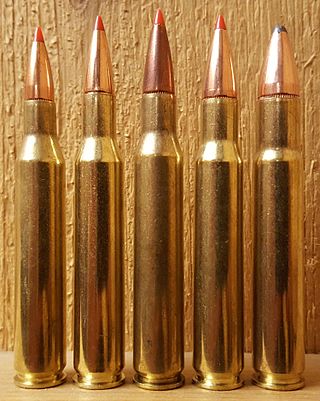
The .270 Winchester is a rifle cartridge developed by Winchester Repeating Arms Company in 1923, and it was unveiled in 1925 as a chambering for their bolt-action Model 54 to become arguably the flattest shooting cartridge of its day, only competing with the .300 Holland & Holland Magnum, also introduced in the same year.
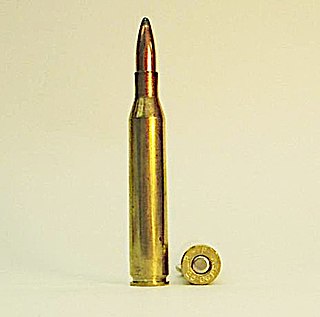
Considered by many as the most balanced of the "quarter bores" for hunting medium-sized game, the .25-06 Remington remained in obscurity as a wildcat cartridge for nearly half a century before being standardized by Remington in 1969.

The 7mm-08 Remington is a rifle cartridge that is almost a direct copy of a wildcat cartridge developed around 1958 known as the 7mm/308. As these names would suggest, it is the .308 Winchester case necked down to accept 7 mm (.284) bullets with a small increase in case length. Of cartridges based upon the .308, it is the second most popular behind only the .243 Winchester. However, the .308 is more popular than both. In 1980, the Remington Arms company popularized the cartridge by applying its own name and offering it as a chambering for their Model 788 and Model 700 rifles, along with a limited-run series within their Model 7600 pump-action rifles during the early 2000s.
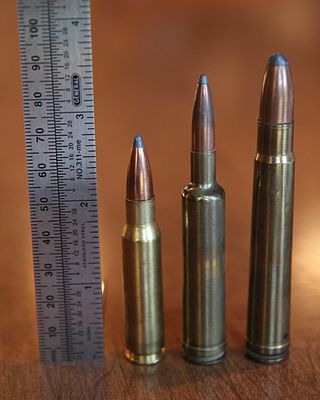
The .257 Weatherby Magnum is a .257 caliber (6.53 mm) belted bottlenecked cartridge. It is one of the original standard length magnums developed by shortening the .375 H&H Magnum case to approx. 2.5 in (64 mm). Of the cartridges developed by Roy Weatherby, the .257 Weatherby Magnum was known to have been his favorite, and the cartridge currently ranks third in Weatherby cartridge sales, after the .30-378 Weatherby Magnum and the .300 Weatherby Magnum.

The .375 H&H Magnum, also known as .375 Holland & Holland Magnum, is a medium-bore rifle cartridge introduced in 1912 by London based gunmaker Holland & Holland. The .375 H&H cartridge featured a belt to ensure the correct headspace, which otherwise might be unreliable, given the narrow shoulder of the cartridge case. The cartridge was designed to use cordite which was made in long strands – hence the tapered shape of the case, which, as a beneficial side effect also helped in smooth chambering and extraction from a rifle's breech.
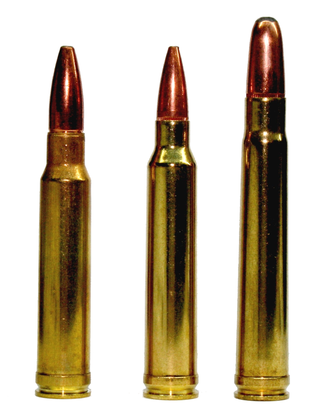
The .300 Winchester Magnum is a belted, bottlenecked magnum rifle cartridge that was introduced by the Winchester Repeating Arms Company in 1963. The .300 Winchester Magnum is a magnum cartridge designed to fit in a standard rifle action. It is based on the .375 H&H Magnum, which has been blown out, shortened, and necked down to accept a .30 caliber (7.62 mm) bullet.

The 7mm Remington Magnum rifle cartridge was introduced as a commercially available round in 1962, along with the new Remington Model 700 bolt-action rifle. It is a member of the belted magnum family that is directly derived from the venerable .375 H&H Magnum. The original purpose of the belted magnum concept taken from the .300 H&H Magnum and .375 H&H Magnum, was to provide precise headspace control, since the sloping shoulders, while easing cartridge extraction, were unsuitable for this purpose. Improved cartridge extraction reliability is desirable while hunting dangerous game, in particular when a fast follow-up shot is required. The 7mm Remington Magnum is based on the commercial .264 Winchester Magnum, .338 Winchester Magnum, and .458 Winchester Magnum, which were based on the same belted .300 H&H Magnum and .375 H&H Magnum cases, trimmed to nearly the same length as the .270 Weatherby Magnum.

The 8mm Remington Magnum belted rifle cartridge was introduced by Remington Arms Company in 1978 as a new chambering for the model 700 BDL rifle. The 8mm Remington Magnum's parent case is the .375 H&H Magnum. It is a very long and powerful cartridge that cannot be used in standard length actions, such as those that accommodate the .30-06 Springfield.

The .35 Whelen is a powerful medium-bore rifle cartridge that does not require a magnum action or a magnum bolt-face. The parent of this cartridge is the .30-06 Springfield, which is necked-up to accept a bullet diameter of .358 in (9.1 mm). This cartridge is more powerful than its parent, especially in killing power on large game. However, with much wider availability, and the higher BC .30 caliber bullets of today, the power gap between the two cartridges has been decreased.
The .300 Remington Ultra Magnum, also known as the .300 Ultra Mag, 7.62×72mm or .300 RUM, is a 7.62 mm rifle cartridge introduced by Remington Arms in 1999. The .300 Remington Ultra Magnum is one of the largest commercially available .30 caliber magnums currently being produced. It is a beltless, rebated rim cartridge, capable of handling all large North American game, as well as long-range shooting. Among commercially produced .30-caliber rifle chamberings, the .300 Remington Ultra Magnum is second only to the .30-378 Weatherby Magnum in cartridge-case capacity.
The .264 Winchester Magnum is a belted, bottlenecked rifle cartridge. Except for the .244 H&H Magnum and .257 Weatherby Magnum, it is the smallest caliber factory cartridge derived from the 2.85 in (72 mm) Holland & Holland belted magnum case. It was introduced in the late 1950s and early 1960s with the .338 Winchester Magnum and the .458 Winchester Magnum as one of a family of short-cased 2.5 in (64 mm) belted magnum cartridges developed by Winchester based on the .375 Holland & Holland parent case. It was officially introduced to the public by Winchester in 1959. After many years of dwindling use it began enjoying a mild resurgence in popularity in the mid-2000s among long range rifle enthusiasts and reloaders due to the high ballistic coefficient of the heavier 6.5mm bullets and increasing popularity of cartridges such as 6.5mm Creedmoor, .260 Remington, 6.5 Grendel, benchrest and wildcat cartridges in 6.5mm.
The .260 Remington cartridge was introduced by Remington in 1997. Many wildcat cartridges based on the .308 Winchester case had existed for years before Remington standardized this round.
The .280 Ross, also known as the .280 Nitro, .280 Rimless Nitro Express Ross (CIP) and .280 Rimless cartridge, is an approximately 7mm bullet diameter rifle round developed in Canada by F.W. Jones as a consultant to Sir Charles Ross, 9th Baronet, and his Ross Rifle Company of Quebec, Canada for use as a Canadian military cartridge as a replacement for the .303 British, and in a civilianised and sporterised version of his controversial Mark II and Mk III Ross rifle, and first commercially produced by Eley Brothers of London, England, in late 1907.

The 7×64mm is a rimless bottlenecked centerfire cartridge developed for hunting. As is customary in European cartridges, the 7 denotes the 7 mm bore diameter and the 64 denotes the 64 mm (2.5 in) case length. The 7×64mm is a popular hunting cartridge in Central Europe due to its 11.95 mm (0.470 in) case head diameter and 84 mm (3.3 in) overall length allowing it to easily be chambered in the Mauser 98 bolt-action rifle that was once standard German military issue.
The .375 Ruger (9.5×65.5mm) is a rimless, standard-length rifle cartridge designed for hunting large, dangerous game. It is designed to provide an increase in performance over the .375 H&H cartridge within the context of a standard-length rifle action. The cartridge was designed in partnership by Hornady and Ruger. In 2007, it was released commercially and chambered in the Ruger Hawkeye African and the Ruger Hawkeye Alaskan rifles.

The .284 Winchester (7.21x55mmRB) is a rebated rim firearm cartridge, introduced by Winchester in 1963.
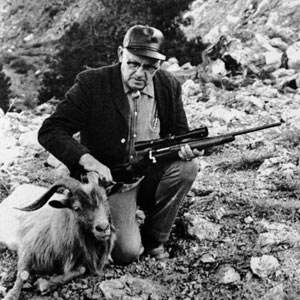
Parker Otto Ackley was an American gunsmith, barrel maker, author, columnist, and wildcat cartridge developer. The Ackley Improved family of wildcat cartridges are designed to be easily made by rechambering existing firearms, and fireforming the ammunition to decrease body taper and increase shoulder angle, resulting in a higher case capacity. Ackley improved not only standard cartridges, but also other popular wildcats, and was the first to create a .17 caliber (4.5 mm) centerfire cartridge.

.30-06 Springfield wildcat cartridges are cartridges developed from a 30-06 Springfield "parent cartridge" through narrowing or widening the cartridge neck to fit a smaller or larger bullet in an attempt to improve performance in specific areas. Such wildcat cartridges are not standardized with recognized small arms standardization bodies like the SAAMI and the CIP.
The .280 Ackley Improved was the result of the .280 Remington case modification by P.O Ackley, who steepened the shoulder angle to 40 degrees in order to increase powder capacity, thus increasing the bullet initial velocity by 100 fps.













